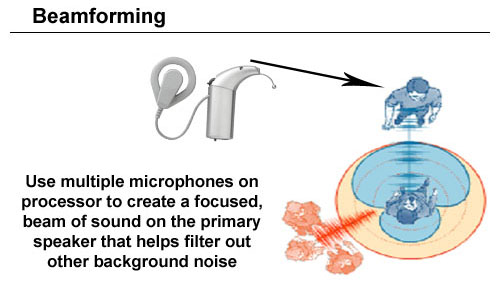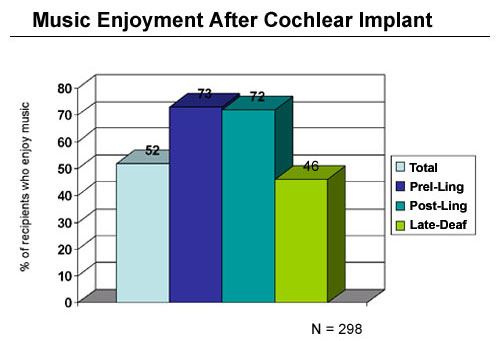Interview with Chris van den Honert Vice President of Research for Cochlear Americas, Vice President of Coding Research for Cochlear Global
Beck: Hi Chris. It's a pleasure to speak with you.
van den Honert: Hi Doug, thanks for the invitation, nice to be here.
Beck: Would you please tell me a little about your education and professional background?
van den Honert: My undergraduate education was at Princeton University, and I was trained in electrical engineering. My graduate work was in biomedical engineering, at Case Western Reserve University in Cleveland. I earned my master's and my Ph.D. there, finishing up in 1979.
Beck: Chris, what was your dissertation on?
van den Honert: It had to do with using electrical stimulation to generate nerve pulses propagating in just one direction on a nerve fiber. Normally nerve fibers carry impulses in only one direction. For example, a motor fiber carries impulses only toward the muscle it controls. This is called orthodromic conduction. But an electrical stimulus usually generates two impulses at the stimulus site - one impulse is conducted in the normal orthodromic direction, and the other is conducted in the opposite, or antidromic direction. My dissertation work involved developing techniques to suppress one of the two impulses.

Beck: Very good. After you earned your Ph.D., where'd you go?
van den Honert: I worked with the 3M Company in St. Paul Minnesota for 11 years, in the Central Research Labs, doing auditory physiology research for cochlear implant applications. Then I joined Duke University and I was in their ENT department for some 5 years. Duke collaborated with the Center for Auditory Prosthesis Research at the Research Triangle Institute (RTI) and then I worked for RTI from 1995 through 1998. That's when I joined Cochlear.
Beck: What type of research are you doing at Cochlear?
van den Honert: That's a broad question. Cochlear has over 100 separate research projects ongoing, both in-house and with academic collaborators around the world. They range from basic science and technology development to clinical applications research. Currently, our lab in Denver is set-up to assess novel speech coding strategies. Doug, I'm sure you recall that some early cochlear implants were percutaneous? Well, we are using new percutaneous implants as research tools, with a small population of volunteer recipients. The percutaneous devices provide a through-the-skin connection to the implanted electrodes, with no intervening radio link. This allows us to test many innovative and novel stimulation strategies using external computers and stimulators - testing which cannot be done with any commercially available implants. The percutaneous implant allows us to rapidly evaluate strategies and protocols before making them available to the patients. After 18 months, the research subjects are revised and the newest commercially available unit is implanted. So back to your question....We work with research subjects to evaluate new speech processing ideas and to help us decide which strategies and systems are likely to provide the best performance. This helps direct our future product development efforts.

Beck: I guess your "bench" research involves hardware too?
van den Honert: Yes, the Nucleus® 24 Contour Advance™ is a new implant that we bench tested using the SofTip™ electrode. We conducted extensive testing in temporal bones with collaborators in Australia, the U.S., and Europe. These tests confirmed that the Contour Advance™ has, by a wide margin, the most atraumatic electrode that we have ever designed - and that it consistently achieves its intended perimodiolar position. We believe that minimizing insertion trauma will be critical to future electrode designs. There has been a general trend toward relaxing the implantation criteria over time as cochlear implant performance has improved, and now we can implant people with useful residual hearing. So the issue of non-traumatic electrode insertion is more important than ever as we strive to preserve the hearing they already have, and improve their auditory perceptions.
Beck: Along those lines, I guess another research area involves people with lesser hearing loss who might use combined cochlear implants & hearing aids?
van den Honert: Absolutely. Some people have sufficient remaining low frequency hearing that they would ordinarily not be implant candidates. But they still derive relatively little benefit from hearing aids. These people may benefit from combining the electrical stimulation of a cochlear implant with low frequency acoustic amplification.

Beck: And I believe I read you're working with the University of Iowa on a project along these lines?
van den Honert: Correct. We're working with them on a device we refer to as a "hybrid" device. It's based on combining residual hearing with electrical stimulation. It's primarily for people with reasonably good low frequency hearing and poor high frequency hearing. Drs. Bruce Gantz and Chris Turner at the University of Iowa are leading a multicenter trial of this technology.
Beck: And so the ideal candidate would have a ski-slope loss?
van den Honert: Exactly. Study candidates must have reasonably good hearing perhaps to 1000 or 1500 Hz, but above that they would have a severe to profound high frequency hearing loss. As you know Doug, these people need lots of help hearing, but traditional hearing aids just don't do a great job with these hearing losses. So the new hybrid device has a very small electrode, about 10 mm in length, inserted only into the high frequency region of the cochlea. Because the electrode is so small, the risk of basilar membrane perforation or other insertion damage is minimized. This device combines acoustic amplification for the low tones, with electrical stimulation to give the high frequency information.

Beck: Wow, that really is amazing. What do the research subjects reveal about their auditory perceptions?
van den Honert: One remarkable thing we've found is that they do very well in noise, particularly when compared to standard cochlear implant and hearing aid patients. We believe that has to do with temporal information, such as voicing information from low frequencies, and that helps identify and separate the voices for the hybrid users. You know, this may be analogous to the situation where normal hearing people do better with background noises such as multiple-talker babble, than they do with white noise. With cochlear implant recipients, the pattern is reversed. Implant patients do better with white noise backgrounds. But hybrid patients are more like normal or moderately hearing impaired listeners - they do better against competitive babble. So the voicing information they receive acoustically probably has something to do with it, but it's early, and we'll see where all of this takes us.
Beck: What can you tell me about cochlear implant recipients perceptions as they relate to music? So many of the patients that I've worked with, and so many that I've interviewed report outstanding results with music.
van den Honert: That's an area we're working on too. I know many cochlear implant recipients report doing well with music, and that's fabulous. However, we believe we can really improve this over time because harmonic relationships and pitch are not particularly well represented by current cochlear implants. I think that despite how good it is, it'll get better, probably based on temporal cues more so than spectral cues. We have several projects underway here and in Melbourne too, to address and improve the percept of voiced versus unvoiced sounds, improved tone, pitch and timing.

Beck: What are the largest obstacles you face with respect to technology? Is it hardware, software, processing power, power supply?
van den Honert: It's really knowledge! The issue 20 years ago was how to squeeze all of these electronics into a package small enough to implant in the temporal bone...but now we've got the right hardware and the right processing power, so we need to better understand how human hearing works, and how to process sound through a cochlear implant, to give the optimal auditory sensation. In the last 20 years, the electronics have pretty much become a non-issue, and the acceleration of circuitry knowledge has outpaced our knowledge of what to do with it!
Beck: What about directional benefits with multiple microphones and noise reduction paradigms?
van den Honert: Sure. There is a lot that can be done with front-end noise suppression, and using a two microphone beam-forming array offers tremendous signal-to-noise benefits on a directional basis. Additionally, we have done some work with Phonak using their wireless products, and the results are just wonderful. So we're very enthused about the potential for continued background noise reduction strategies.
Beck: Any predictions for the next 3 to 5 years? What's the next giant stride on cochlear implants?
van den Honert: Well, one we're all thinking about and progressing toward is the completely implantable cochlear implant system, and all the implant manufacturers are working on this too. Of course, there are tremendous benefits to the completely implanted system for cosmetic and water issues, like for swimming and bathing, but there are trade-offs too. It's a tremendous challenge to get a clean audio signal from an implanted microphone. Having the tiniest unit completely implanted will likely yield less than the broadest selections of speech processing programs and abilities. In essence, you can always do more with a big box, than you can with a small box! Then again, we believe we need to properly inform and counsel the patients, and let them select their preference, based on their needs and desires.
Beck: Thanks so much for your time today. I always enjoy learning about new developments in cochlear implant technology, and it really is fun speaking with you.
van den Honert: Thanks Doug. It's been my pleasure.
- - - - - -
For more information about Cochlear Implants click here.

